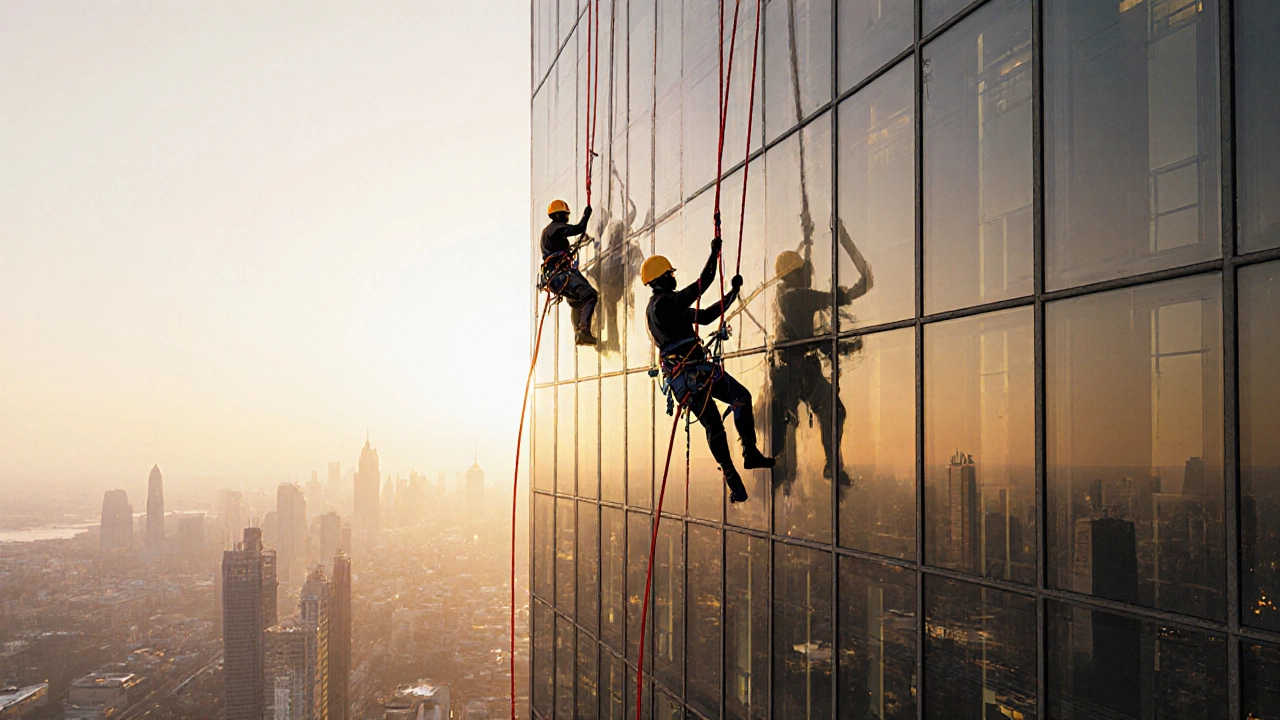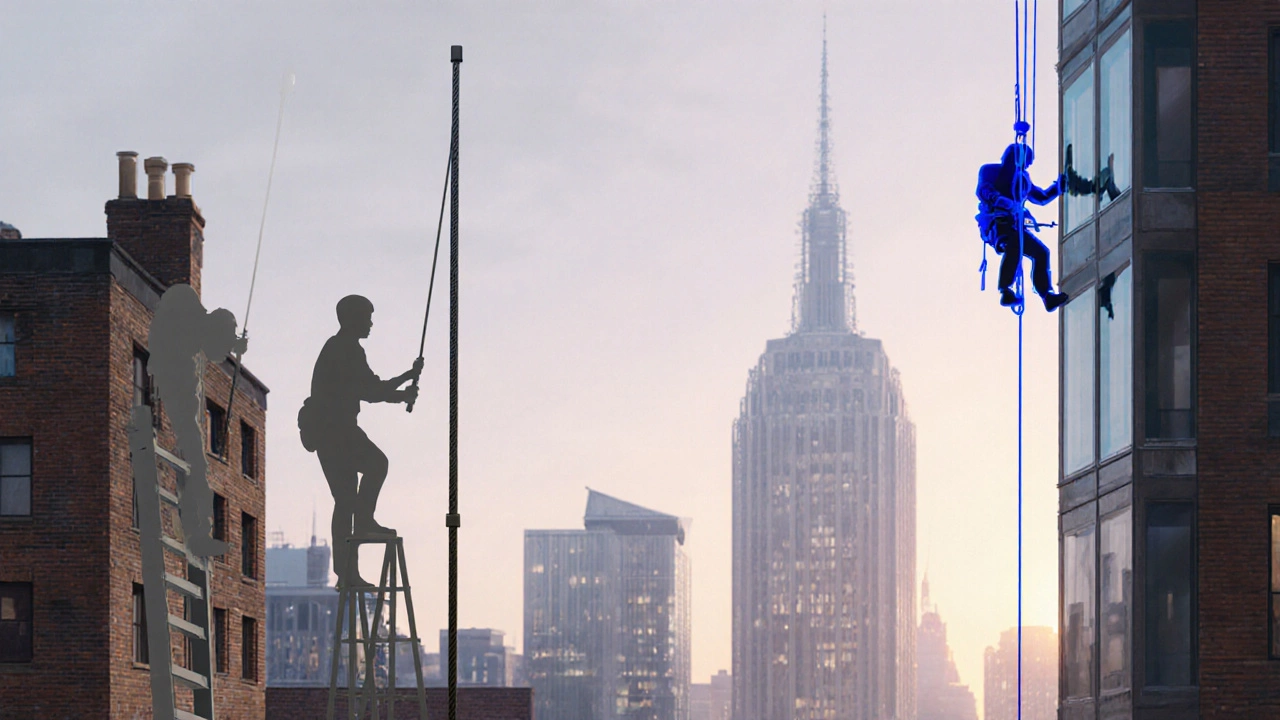Window Cleaning Method Comparison Tool
Select a window cleaning method below to learn about its features, safety considerations, and cost implications.
Ladder
Traditional method with limited reach and higher risk
Water-Fed Pole
Efficient, safe, and environmentally friendly
Rope Access
Best for high-rise buildings and complex structures
When you think of window cleaning today, ladders are often out of the picture. In the past, a simple step‑ladder was the go‑to tool for every residential or commercial job. Now professional crews are reaching dozens of metres into the sky with lightweight poles, harnesses and specialized water systems. So why have ladders faded from the toolbox? The answer lies in a mix of safety law, smarter technology and bottom‑line economics.
From Ladders to Pole‑swinging: What Triggered the Shift?
Ladder use in the UK has been on a steady decline since the early 2010s. The Health and Safety Executive (HSE) tightened regulations after several high‑profile falls, making it harder for small operators to justify a ladder‑only approach. At the same time, manufacturers introduced water‑fed pole systems that can clean a 50‑foot window from the ground.
These poles are telescopic, made from carbon fibre, and weigh less than a five‑kilogram sack of potatoes when fully extended. Coupled with a purified water system that removes minerals, the result is a spotless pane without the need for harsh chemicals or ladder‑borne risk.
How Water‑Fed Poles Work
A typical water‑fed pole consists of three parts: a telescopic extension pole, a brush head, and a hose that feeds ultra‑pure water. The water is filtered through a 0.2‑micron cartridge, ensuring it won’t leave mineral streaks. When the brush scrubs the glass, the flowing water carries away dirt instantly.
- Reach: up to 30m (98ft) on a single pole.
- Weight: 2-5kg for a 12‑m pole, making it easy for one person to handle.
- Cleaning time: 30% faster than ladder‑based methods for multi‑storey blocks.
Because the operator stays on solid ground, fall risk drops to virtually zero. Insurance premiums for a pole‑only crew can be 20% lower than those for a team that still uses ladders.
Rope Access: The Specialist’s Answer to the Sky
For skyscrapers where a pole can’t reach, firms turn to rope access technicians. These workers are trained to the IRATA (International Rope Access Trade Association) standards, using a safety harness and a dual‑rope system. One rope bears the load, while the second acts as a backup, creating a “fall‑arrest” system that meets HSE’s strict requirements.
Rope access crews can clean windows on towers taller than 200m, something a pole simply cannot do. The method still beats a traditional scaffold‑and‑ladder approach in terms of set‑up time - often under two hours compared with a full‑day scaffold erection.

Safety Regulations: The Real Engine Behind the Change
The UK’s HSE published the “Working at Height” guidance in 2014, which states that “ladders must be a last resort when no safer alternative exists.” The guidance forces contractors to produce a documented risk assessment before any ladder‑based job. If a pole or rope system can achieve the same result, the agency expects it to be deployed.
Non‑compliance can lead to hefty fines-up to £20,000 per breach-and, more importantly, potential criminal prosecution if a worker is injured. Many small cleaning businesses have switched to pole systems simply to stay on the right side of the law.
Cost and Efficiency: Why Clients Prefer Ladder‑Free Service
From a business standpoint, the numbers add up quickly. A typical pole setup costs £3,500-£5,500 upfront, while a full‑time ladder‑based crew might require £2,000 in annual ladder maintenance alone. More importantly, the time saved translates into more jobs per day.
- Average job time for a 10‑storey flat: 2hours with poles vs 3hours with ladders.
- Fuel savings: pole crews avoid the diesel generators often needed for scaffold lifts.
- Customer satisfaction: ground‑level crews are less noisy, cause fewer disruptions, and appear more professional.
All these factors push pricing down by roughly 10% for the end‑user, making ladder‑free service a competitive selling point.
What Homeowners Should Expect When Booking a Service
If you call a local window cleaning company today, they’ll likely ask two questions: the height of the windows and whether any obstacles (like awnings or external lighting) are present. Based on the answers, they’ll decide whether a water‑fed pole, rope access, or a hybrid approach is best.
Most reputable firms will provide a brief safety briefing, show their certifications (IRATA or HSE authorisation), and explain the equipment they’ll use. You should see a technician in a high‑visibility jacket, a harness if they’re on a rope, and a lightweight pole with a brush head ready to roll.

DIY Ladder‑Free Options for the Handy Homeowner
Do you want to clean your own ground‑floor windows without a ladder? A short extension pole (2-3m) with a detachable brush can be bought for under £50. Pair it with a bucket of distilled water and a squeegee, and you have a low‑risk, chemical‑free setup.
For higher stories, renting a pole system from a local equipment hire shop is often cheaper than hiring a professional crew for a single window. Just make sure you read the user manual - the pole can become a danger when extended too far without proper anchoring.
Toolbox Comparison: Ladder vs Pole vs Rope Access
| Feature | Ladder | Water‑Fed Pole | Rope Access |
|---|---|---|---|
| Maximum reach | ~5m (16ft) | ~30m (98ft) | 200m+ (656ft) |
| Operator position | Elevated, unstable | Ground‑level, stable | Suspended, harnessed |
| Safety risk | High - fall hazards | Low - no height exposure | Medium - requires training |
| Setup time | Minutes | 10‑15min | 30‑45min |
| Typical cost per job | £80‑£120 | £100‑£150 | £200‑£300 |
| Environmental impact | Requires chemicals | Uses purified water only | Uses minimal water, low‑impact |
Future Outlook: Will Ladders Disappear Completely?
Even with advanced pole and rope technology, ladders aren’t vanishing overnight. They still serve niche roles-tight interior spaces, low‑profile cleaning under eaves, or quick spot‑checks where a full pole setup would be overkill. However, for the majority of commercial and high‑rise residential jobs, ladders have become the least efficient, safest, and most costly option.
Industry forecasts suggest that by 2030, over 85% of professional window cleaning contracts in the UK will list a pole or rope‑access method as a core requirement. Regulations will likely tighten further, and training providers are already shifting curriculum toward pole‑handling and IRATA certification.
Frequently Asked Questions
Are water‑fed poles safe for residential use?
Yes. The operator stays on the ground, eliminating fall risk. The poles are built from carbon fibre, which can support the brush and water flow without bending. As long as the user follows the manufacturer’s weight limits, the system is as safe as any garden hose.
Do I need a licence to hire a rope‑access window cleaning crew?
Professional rope‑access technicians must hold an IRATA or equivalent certification. Reputable firms will display their certificates or provide proof upon request. Homeowners do not need a licence; the responsibility lies with the service provider.
How does purified water prevent streaks?
A 0.2‑micron filter removes virtually all minerals, so when the water evaporates it leaves no residue. This means you can clean windows without using any detergent, and the glass stays crystal clear.
Can I rent a water‑fed pole for a one‑off job?
Many equipment hire shops in the UK offer daily or weekly rates for poles ranging from 5m to 12m. Ask about insurance coverage and any required training before you take it home.
Why do some cleaners still use ladders for low‑rise windows?
For a single‑storey garden shed or a ground‑level storefront, a short step‑ladder can be the quickest tool. The risk is low, the cost negligible, and the setup time is almost instant. In these narrow cases, ladders remain practical.




